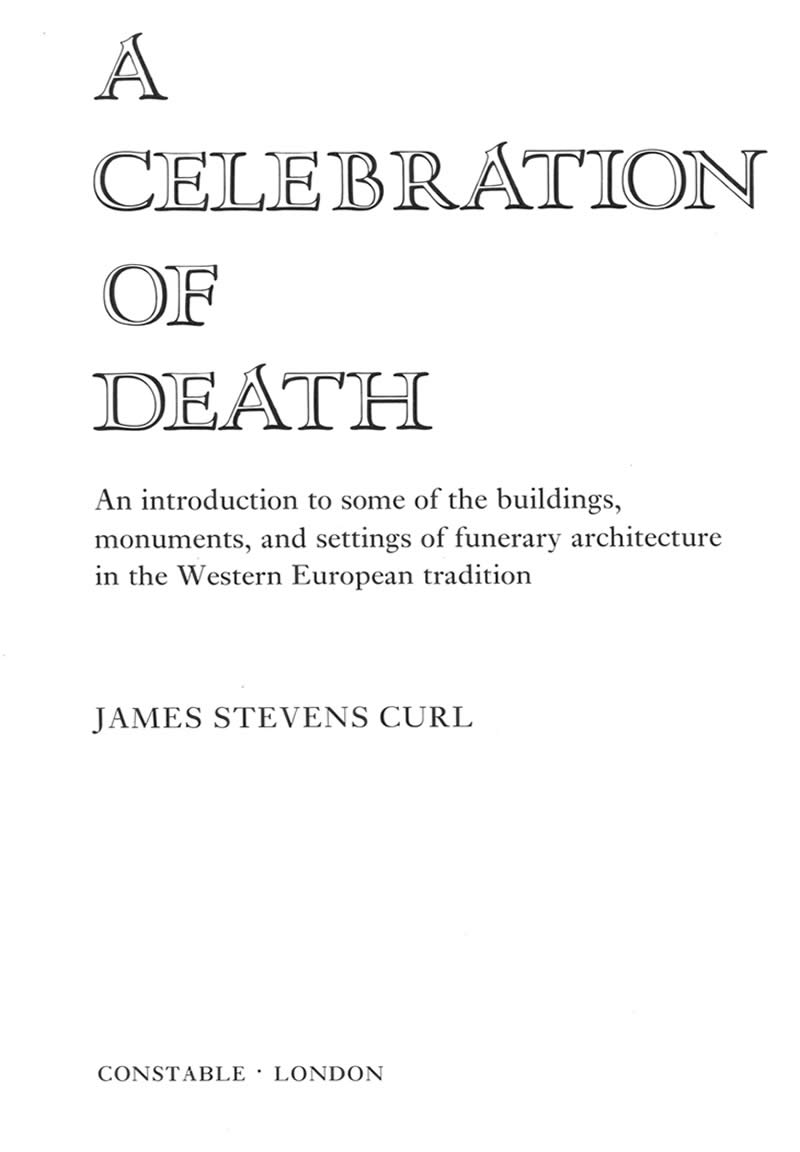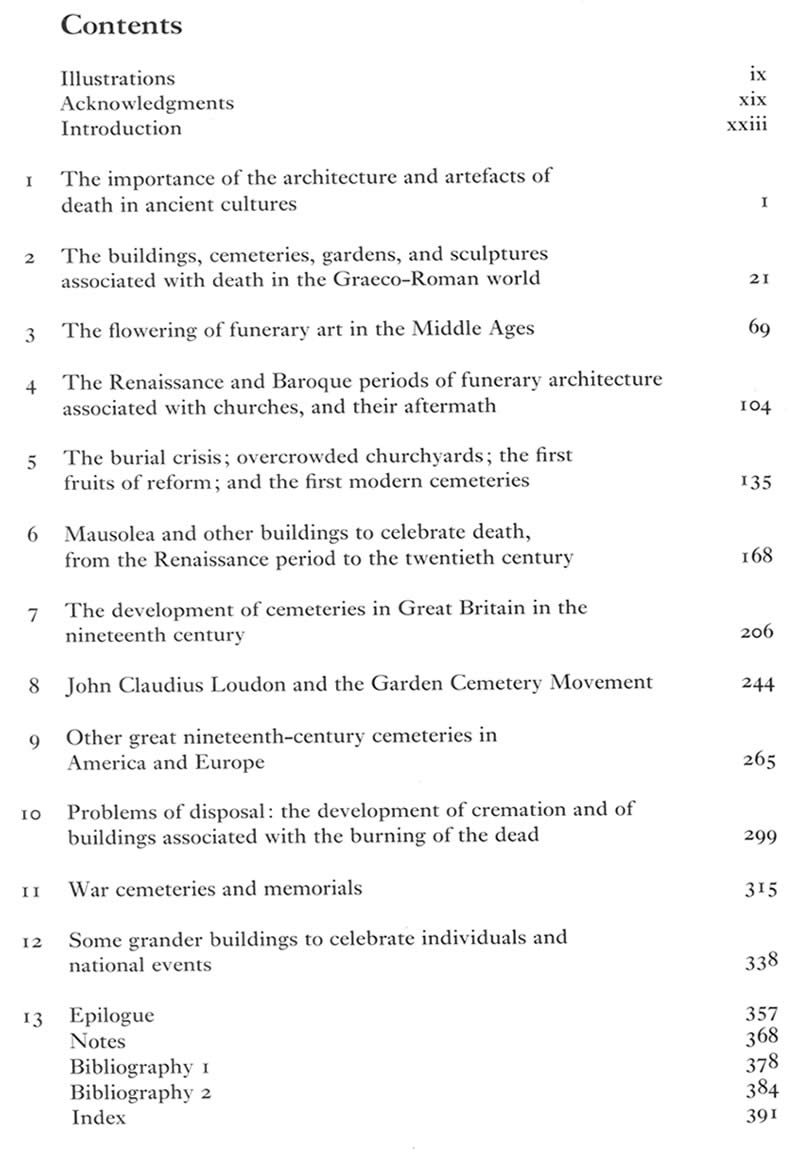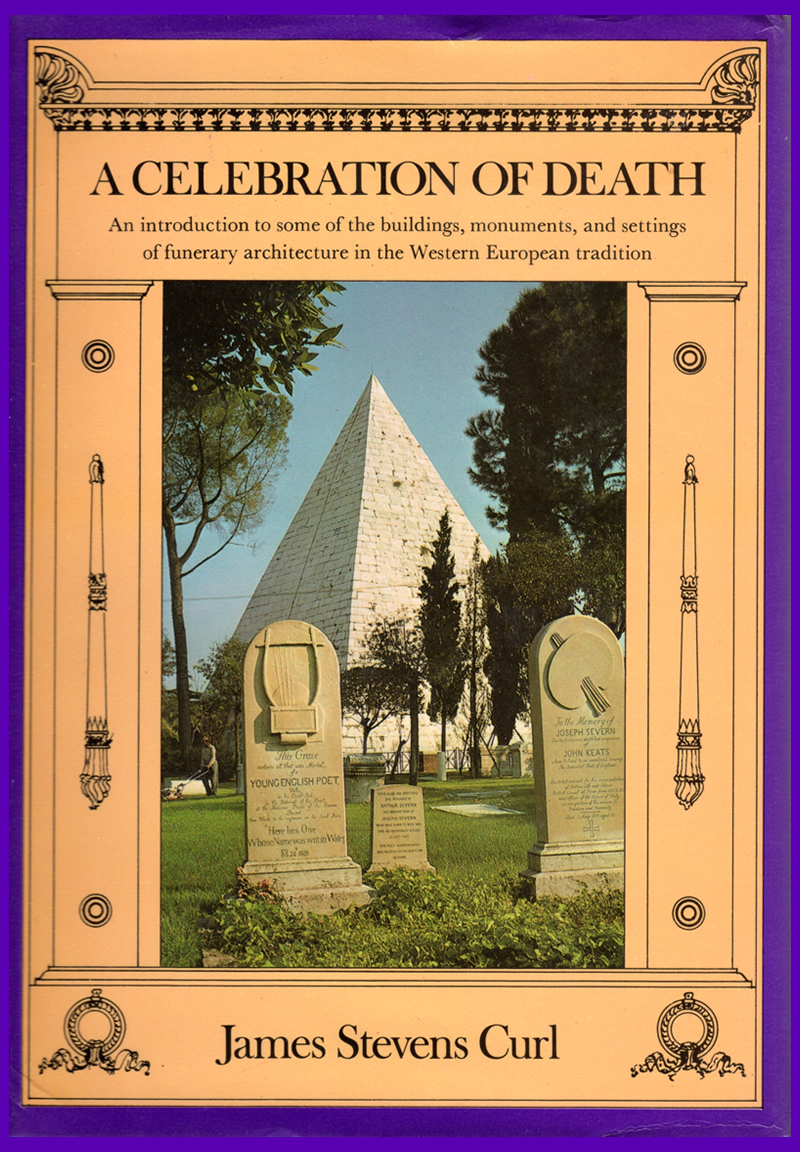A Celebration of Death: An Introduction to Some of the Buildings, Monuments, and Settings of Funerary Architecture in the Western European Tradition

Author : James Stevens Curl
Publisher : London: Constable & Co. Ltd., 1980
ISBN: 0-09-463000-32 (hbk)
The subjects of funerary architecture, of commemorative structures, and of cemeteries, have suffered a curious neglect at the hands of recent writers until works such as this started to redress the balance and inform a whole range of new studies now eagerly pursued by younger scholars. Travellers from Herodotus to Baedeker have sought out the tombs and mausolea of prehistory, of Classical, and of mediaeval times, but the cemeteries of London and of other great cities have largely been ignored by commentators. Is this, perhaps, because we play down death, robbing it of its significance, and disposing of our dead as we dispose of unwanted waste products? If so, this is a comparatively recent attitude, for even the Victorians invested Death with all due ceremony, and their monuments reflect belief in certain Resurrection. Today, those monuments are often neglected and vandalised: the ephemeral nature of life, of fame, and of love is obvious to the beholder of overgrown graveyards and wrecked monuments.
This comprehensively illustrated book was enthusiastically acclaimed when it first appeared, and remains a contribution to understanding the architecture of death.
A second, revised edition came out 13 years later (London: B.T. Batsford Ltd., 1993, ISBN: 0-7134-7336-3 [pbk.]), and later still a further revised version entitled Death and Architecture: An Introduction to Funerary and Commemorative Buildings in the Western European Tradition, with Some Consideration of their Settings (Thrupp, Stroud: Sutton Publishing Ltd., 2002, ISBN: 0-7509-2877-8 [hbk.]).
Reviews
'It’s not exactly graves and graveyards, and in a sense it is festive in that it’s about celebration. It is a celebration of lives that are over and finished. Much of the world’s greatest architecture has been about death; much of the world’s greatest music has been about death. Think of the Taj Mahal, think of the Verdi Requiem, think of Gray’s Elegy, think of things like the Lament of Art O’Leary, and we realise how death has given rise to a great deal of fine art. This book is not so much about graveyards as about monuments and tombs, above all, of course, mausolea. The author covers the whole of Europe and a little of the near east, as well as places outside Europe. He says in his preface that his whole appetite for the subject was whetted by a childhood spent in the melancholy landscape of Ireland: and Ireland is rich in funerary architecture of one sort or another. The author has covered his subject superbly well, and 1 think the whole production is a very fine illustrated book. The pictures are of a very high quality, and the author has done his homework thoroughly and professionally.'
'... a remarkable ... study of funerary architecture in the Western European tradition, sparingly entitled A Celebration of Death. I reviewed it at some length in The Times, and anyone who reads that paper will know the high opinion I formed of the book.'
'A Celebration of Death is a perfect complement to Ariès’ study and affords an encyclopaedic view of buildings, monuments, and settings of funerary architecture ... Pictorially well conceived, descriptively rich in anecdotes and information, and culturally meaningful, Curl’s book synthesises art and ideology.'
'…the monumental work now before us cannot but be welcomed... the immense amount of research that has gone into the present publication is clear ... In all the rich variety of illustration and scholarly comment which is placed before us one message comes over as clear as the last trump - a monument is intended to be a lasting memorial ... This ... book... is an important and timely publication which deserves to play a significant part in ensuring a proper appreciation of, and greater respect for, our neighbours’ landmarks.'
'In 1972 Curl published The Victorian Celebration of Death, an account of the beginnings of the Victorian cemetery movement ... At that time the subject had barely been examined, certainly never in such depth... it provided the initial spark for many of those now involved in this field; and it may fairly be said that with that book Mr. Curl created cemetery studies as a scholarly discipline. Now he has brought out a sequel, which greatly expands the range of what must now be called funerary studies. Historians of landscape will be grateful for such a mass of information gathered into one compass ... Curl has painted an enthralling picture ... I cannot leave the subject without commenting on A Celebration as a physical object. it is a beautiful piece of bookmaking ... Potential publishers of books on garden history ought to examine this volume as an exemplary specimen.'
'... extremely well researched and presented mixture of socio-history and architectural history ... almost always ... fascinating and readable...We are delighted to be able to recommend this work most highly...'
'Scribner’s has long been regarded as a class publishing house, and nowhere in recent memory does its professionalism come more quickly to the fore than in James Stevens Curl’s A Celebration of Death. Amply illustrated... the book gives new insight into some of the Western world’s most stunning monuments to the dead. Accompanying the illustrations is Curl’s text, which is a study in clarity, historical acumen, and how a writer can combine elegant prose with utter clarity without creating a style that is either overblown or banal. A good book... it is ... interesting, highly informative, and craftsmanlike in all respects.'
'Curl comes into his own in ferreting out the unknown and the unexpected ... his book is a source of constant, never morbid, fascination.'
'... the book is timely and important ... Mr Curl has tackled a neglected and largely uncharted subject, and he has drawn attention to much splendid...architecture...I admire the book...'
'… a large and beautifully illustrated book ... Curl’s taste is very catholic indeed ... his text is a useful and interesting presentation of very valuable material. He is excellent on Père-Lachaise, and writes with warmth and perception about all the grander aspects of his subject.'
'Curl has established his credentials in this field ... Mr Curl brings to his subject the zest which it demands. He is more than half in love with his subject, and the excellence of his illustrations fitly complements his text ... a prodigious quantity of information is here assembled, as never before in English.'
'A most astonishing work on funerary architecture ... of a positively noble scope and sweep and scale.'
'A richly illustrated book ... Apart from its intrinsic interest, Curl’s Celebration reveals an important historical point, the role of funerary architecture in the development of architectural style… Curl has paid due regard to the tomb. I salute his study and recommend it for a fresh look at immortality.'
'A source of wonder and delight...The book’s publication should itself be celebrated, for its virtues are many and important.'
'An admirable culmination of research over several years...a fascinating study.'




 LinkedIn
LinkedIn  Wikipedia
Wikipedia